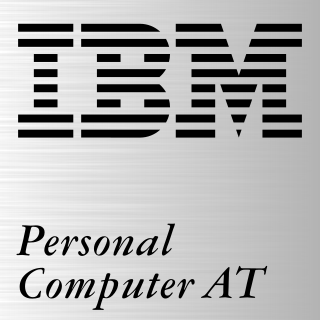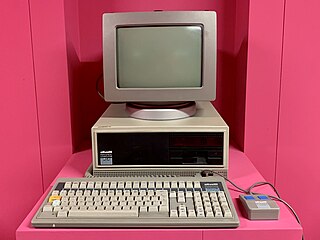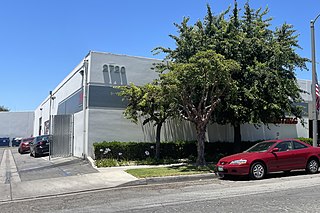
The 8086 is a 16-bit microprocessor chip designed by Intel between early 1976 and June 8, 1978, when it was released. The Intel 8088, released July 1, 1979, is a slightly modified chip with an external 8-bit data bus, and is notable as the processor used in the original IBM PC design.

The Intel 8088 microprocessor is a variant of the Intel 8086. Introduced on June 1, 1979, the 8088 has an eight-bit external data bus instead of the 16-bit bus of the 8086. The 16-bit registers and the one megabyte address range are unchanged, however. In fact, according to the Intel documentation, the 8086 and 8088 have the same execution unit (EU)—only the bus interface unit (BIU) is different. The 8088 was used in the original IBM PC and in IBM PC compatible clones.

The Intel 386, originally released as 80386 and later renamed i386, is a 32-bit microprocessor introduced in 1985. The first versions had 275,000 transistors and were the central processing unit (CPU) of many workstations and high-end personal computers of the time.

The Tandy 1000 is the first in a line of IBM PC compatible home computer systems produced by the Tandy Corporation for sale in its Radio Shack and Radio Shack Computer Center chains of stores. Introduced in 1984, the product line was aimed at providing affordable but capable systems for home computing or education, with some of its Tandy specific features like graphics, sound and joystick port making it more appealing for home use.

The Personal System/2 or PS/2 is IBM's second generation of personal computers. Released in 1987, it officially replaced the IBM PC, XT, AT, and PC Convertible in IBM's lineup. Many of the PS/2's innovations, such as the 16550 UART, 1440 KB 3.5-inch floppy disk format, 72-pin SIMMs, the PS/2 port, and the VGA video standard, went on to become standards in the broader PC market.

The IBM Personal Computer AT was released in 1984 as the fourth model in the IBM Personal Computer line, following the IBM PC/XT and its IBM Portable PC variant. It was designed around the Intel 80286 microprocessor.

The Amstrad PC1512 was Amstrad's mostly IBM PC-compatible computer system, first manufactured in 1986. Next year a slight updated version named PC1640 was introduced. It was also marketed as PC6400, and Sinclair PC500. Schneider branded machines for the German market also exists.

Chips and Technologies, Inc. (C&T), was an early fabless semiconductor company founded in Milpitas, California, in December 1984 by Gordon A. Campbell and Dado Banatao.

The NEC V20 is a microprocessor that was designed and produced by NEC. It is both pin compatible and object code compatible with the Intel 8088, with an instruction set architecture (ISA) similar to that of the Intel 80188 with some extensions. The V20 was introduced in March 1984.

The PC-9800 series, commonly shortened to PC-98 or 98, is a lineup of Japanese 16-bit and 32-bit personal computers manufactured by NEC from 1982 to 2000. The platform established NEC's dominance in the Japanese personal computer market, and, by 1999, more than 18 million units had been sold. While NEC did not market these specific machines in the West, it sold the NEC APC series, which had similar hardware to early PC-98 models.

The Leading Edge Model D is an IBM clone first released by Leading Edge Hardware in July 1985. It was initially priced at $1,495 and configured with dual 5.25" floppy drives, 256 KB of RAM, and a monochrome monitor. It was manufactured by South Korean conglomerate Daewoo and distributed by Canton, Massachusetts-based Leading Edge. Engineer Stephen Kahng spent about four months designing the Model D at a cost of $200,000. Kahng later became CEO of Macintosh clone maker Power Computing.
The Commodore PC compatible systems are a range of IBM PC compatible personal computers introduced in 1984 by home computer manufacturer Commodore Business Machines.

The Olivetti M24 is a computer that was sold by Olivetti in 1983 using the Intel 8086 CPU.
In computer architecture, 16-bit integers, memory addresses, or other data units are those that are 16 bits wide. Also, 16-bit central processing unit (CPU) and arithmetic logic unit (ALU) architectures are those that are based on registers, address buses, or data buses of that size. 16-bit microcomputers are microcomputers that use 16-bit microprocessors.

The Deskpro 386 is a line of desktop computers in Compaq's Deskpro range of IBM PC compatibles. The computers feature Intel's 32-bit 80386 microprocessor. Introduced in September 1986, the Deskpro 386 is the first implementation of the 80386 processor in a computer system for sale to the public. It also marks the first time that a major component of the IBM Personal Computer de facto standard was updated by a company other than IBM themselves—in this case, upgrading from the 80286 processor of the Personal Computer/AT.

The Sharp PC-7000 is a luggable portable computer released by Sharp Electronics in 1985. The PC-7000 was Sharp's second entry into the IBM PC-compatible portable computer market, their first being the PC-5000.

American Computer & Peripheral, Inc. (AC&P), also written as American Computer and Peripheral, was an American computer company based in Santa Ana, California. The company was founded in 1985 by Alan Lau and released several expansion boards for the IBM PC as well as a few PC clones before going bankrupt in December 1989. Obscure in its own time, the company's 386 Translator was the first plug-in board for Intel's newly released 80386 processor and the first mass-market computing device to offer consumers a means of using the 386 in July 1986.

The Tandy 1400 LT is the first MS-DOS compatible laptop sold by Tandy Corporation. Introduced in November 1987, it had two 3.5 inch floppy drives and a flip-up monochrome LCD screen, powered by an internal battery.

The Personal System/2 Model 30 and Personal System/2 Model 30 286 are IBM's entry-level desktop computers in their Personal System/2 (PS/2) family of personal computers. As opposed to higher-end entries in the PS/2 line which use Micro Channel bus architecture, the Model 30 features an Industry Standard Architecture bus, allowing it to use expansion cards from its direct predecessors, the PC/XT and the PC/AT. The original PS/2 Model 30 is built upon the Intel 8086 microprocessor clocked at 8 MHz; the Model 30 286 features the Intel 80286 clocked at 10 MHz.

The SupersPort is a line of PC-compatible laptops manufactured by Zenith Data Systems and sold from 1988 to 1993. The first two main entries in the SupersPort line included either an Intel 80286 microprocessor clocked at 12 MHz or an 8088 processor clocked at 8 or 4.77 MHz, switchable. Later entries included the 386SX, 486SX and 486 processors. The SupersPort 286 in particular was one of the top-selling laptops of the late 1980s, although Zenith's position in this segment faltered by the early 1990s.


















